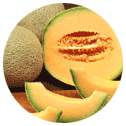Calabash Fruit
Scientific name - Crescentia cujete
Calabash is native to Central and South American regions. The species grows dense typically in tropical and subtropical areas and it yields a large, hard, green skinned fruit which is otherwise known as long melon. The flesh of the fruit helps cure skin conditions. The fruit is oblong, short-stemmed, green or purplish and measures 15 to 20 centimeters in diameter.
| Principle |
Nutrient Value |
Percentage of RDA |
|---|
| Energy |
14 Kcal |
<1% |
| Carbohydrates |
3.39 g |
2.5% |
| Protein |
0.62 g |
1% |
| Total Fat |
0.02 g |
0.5% |
| Cholesterol |
0 mg |
0% |
| Dietary Fiber |
0.5 g |
1% |
| Vitamins |
|
|
| Folates |
6 µg |
1.5% |
| Niacin |
0.320 mg |
2% |
| Pantothenic acid |
0.152 mg |
3% |
| Pyridoxine |
0.040 mg |
3% |
| Riboflavin |
0.022 mg |
2% |
| Thiamin |
0.029 mg |
2.5% |
| Vitamin A |
16 IU |
0.5% |
| Vitamin C |
10.1 mg |
17% |
| Electrolytes |
|
|
| Sodium |
2 mg |
<1% |
| Potassium |
150 mg |
3% |
Medicinal Uses of Calabash Fruit
- Cure asthma and cough
- Cure dysentery and stomach aches
- Reduce blood pressure
- Treat hematomas and tumors
|
 |


















